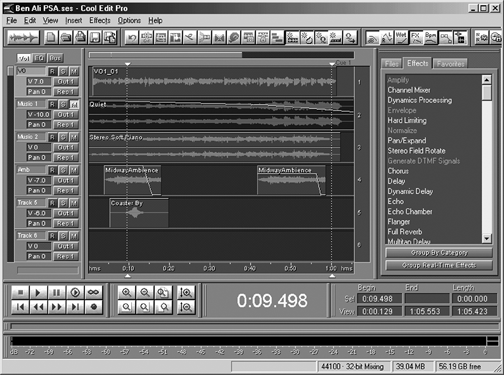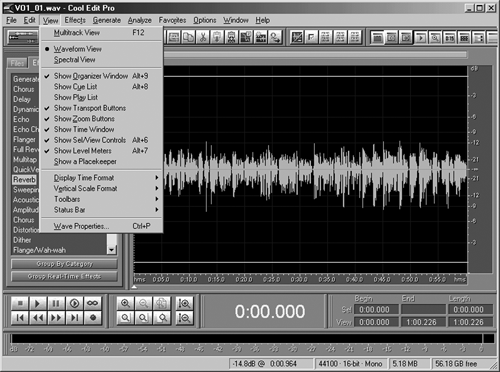
THE INTERFACE
If you’re a Cool Edit veteran, then you’ll feel right at home with Cool Edit Pro 2.0, as not a lot has changed. Most commands are still right where you left them. If you’re new to Cool Edit Pro 2.0, you’ll find it a bit like playing the piano for the first time; it’s easy to play but not easy to play well. To be really quick on CEP2, you’ll still need to memorize many of the keyboard equivalents and mouse tricks available that mimic most of the menu commands. Syntrillium offers a PDF file on their website that will show you five pages of keyboard and mouse equivalents — get it, you’ll be able to work a lot faster.
Mouse and keyboard commands are well-supported in both the Edit View (a single track) and the Multitrack View. For example, if you have a mouse with a scroll wheel (like the Intellipoint mouse), then moving the wheel forward zooms in and moving it backwards zooms out, which is very slick. Right-clicking on the Amplitude ruler in the Edit View zooms vertically.
Both the Edit and Multitrack Views can also display an Explorer-like Organizer on the left side, with three tabs that let you browse different items. The first tab is Files, where you can load and audition any CEP2 compatible audio file from your hard disks. You can then drag any of the listed files onto the time line to place it. The second tab shows you all available effects, and gives you several sorting options. The third tab in the Organizer is Favorites, where you can drag your most-used effects for quick retrieval.
This new Organizer window is a handy device for speeding up your workflow. For example, you can load a number of music beds you are considering for a spot, and audition them before actually placing them on tracks. The Favorites tab is essential if you have a large number of effects — and you will, since 45 are included with CEP2. While you can resize it, the Organizer does eat a sizeable chunk of valuable screen real estate, giving us yet another reason to use a large monitor with Cool Edit Pro 2.0.
As you might have guessed, CEP2 maintains the two-view approach of its older siblings, with a button in the upper left that switches between the Multitrack View and the single-track Edit View. Both views use the top of the screen for the customizable toolbar and the scroll bar, and the bottom of the screen for transport controls and counters.

EDIT VIEW
The Edit View is the best view for surgical editing. The center shows you a single mono or stereo track in detail, and if you zoom in far enough then individual samples become draggable points that can be adjusted to fix a bad edit or eliminate a click. The menu bar gives you access to all the usual edit suspects like cut, copy, paste, trim, unlimited undo, and also lets you apply any effects to the track.
From the Edit View, CEP2 can perform batch processes to individual files by means of scripts. You can have a script that runs all your clips through a limiter set to -3dB to prepare them for CD burning, or you can run a portion of a single file through a batch that turns the sound into laser blasts. A script command allows you to simply perform a series of steps and they’ll be recorded... no programming required.
Like previous versions of Cool Edit Pro, effects applied in the Edit View are not real-time. Instead, invoking most effects presents you with a dialog box and a Preview button. You adjust the effect from within the dialog box until you like it, then press OK. CEP2 then generates a new temporary file with the effect applied and displays that waveform. You can undo the effect and get the original file back until you save. In addition, effects can only be applied individually, not in a chain. For chaining and for real-time effects, you must work in the Multitrack View.
